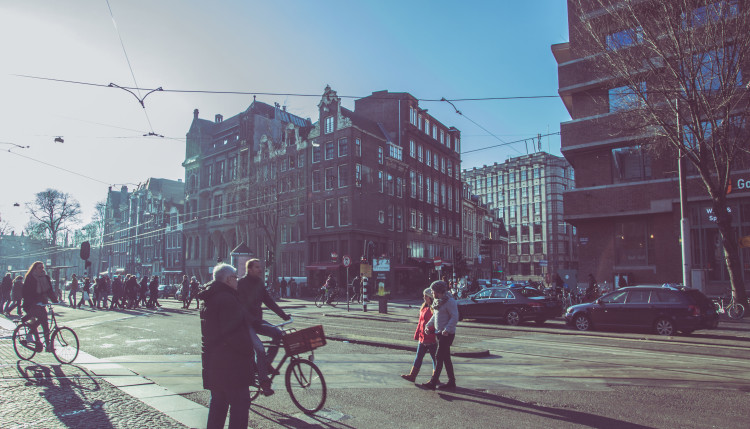
Sustainable mobility: the key to efficiency in cities
Faced with population growth and the higher concentration in urban centers, mobility of citizens is presented as one of the great challenges of the XXI century. Pedestrian, greater use of bicycles, promotion of public transport and car disincentive are, according to experts, the keys to more humane and sustainable cities.
Take a trip that in any other city in the world can take about 20 minutes, in the Federal District of Mexico can be extended to an hour, or even two. But what is most striking is that, away from a crowded scene of horns, shouting and discomfort, the situation seems to have been naturalized. How it came to this reality? Why in cities like Mexico, Lima and Sao Paulo the car became the main character? According to the United Nations, by 2050 it is expected that 70% of the world population lives in cities, mainly in developing and emerging countries. How will mobilize 70 million people that each year join the world?
The problems began to settle in the different governments and institutions from the need for a paradigm shift from transport to mobility. «The key in cities is that there is an economic success with social equality. And this depends on the way we design cities for mobility», said Brent Toderian, former chief planner of Vancouver, Canada. This Canadian city planner, who advised many cities like Medellin, Sydney and New York, is blunt about it: «Cities have been designed for the vehicle. It is necessary to reorganize mobility in them as an efficient hierarchy: people, bicycles, public transport, freight transport and the private car».
PEDESTRIAN
«Cities have the ability to provide something for everyone, just because, and only when, they are created by everybody», said the ’60 American urban activist, Jane Jacobs. The paradigm shift has placed -or has returned- the person as the real star of the big cities.
«The most concrete benefit is economic. The people walking uses local products and services to meet their needs, enabling economic development of the place», says Carolina Huffmann, architect and founder of the initiative City Walks. Most pedestrian streets allows the connection of spaces in cities and facilitate pedestrian access to activities, businesses to visit, places to rest and others with whom to socialize. «Cities must be places of displacement, as the right to mobility is a right to the city. If you can´t move, you can´t have access to work, education, health» says Andrés Borthagaray, architect and director for Latin America of the Institut pour la ville en mouvement.
The more people on the streets, there will be another fringe benefit: greater security. «Jacobs said that `more people, one is surrounded by strangers'», recalls Huffmann. The seller, the keeper, the greengrocer become a sort of «guardian of the street» always present and attentive to a pedestrian unknown but with whom they share a space: the public.
In Latin America the pedestrian has started to be main character through strategies and policies for pedestrian on the main streets, greater security and access to multiple crossings, and more opportunities to, for example, sitting in the street. According to Huffmann, what the region still needs to improve is to respect the pedestrian as figure. While in cities like London the cars slow down to a crosswalk, crossing a street in Lima in rush hour can become an ordeal, even with the lights in favor.
From the environmental point of view, prioritize the person contributes in reducing emissions of greenhouse gases (GHGs) in the atmosphere and noise pollution, improving the quality of life of people. In Seville, Spain, policy in favor of pedestrian helped to reduces by 5,000 tons of GHGs in one year.
THE BIKE
According to a study by the European Cyclists’ Federation, the bike produces just 21 grams of carbon dioxide (CO2) compared to 101 grams emitted by a bus and a car 271. Its promotion was strategically made in recent years through public or semi-public systems that allow, for free or paid, access to a bicycle located in a strategic area and to leave it in another closer to the destination station. This is accompanied by awareness campaigns and infrastructure to facilitate transfer through preferential bike paths or roads.
While in London, Barcelona and Paris, you must pay for the system, in Buenos Aires still retains its free and since two months ago works automatically 24 hours. Denmark has been one of the highlights in incorporating the use of bicycles countries. The study by the Federation provides that if all EU countries reach Denmark´ level of CO2 emissions would be reduced between 63 and 142 million tons by 2050.
PUBLIC TRANSPORT
The hike and bike use are allowed for relatively short distances. What happens when we have to move from one neighborhood to another, more distant, or even when we came to the city from its surroundings? The answer, according to Toderian, is clear: the public transport. More and better connections between subway lines, optimizing the quality of intercity trains, and strategic access the group to Metrobus are some of the current policies that predominate in Latin America.
According to Borthagaray, the main challenge for Buenos Aires in the transition to sustainable mobility, is the continuity and strength of investment in public transport. «We have 814 kilometers of suburban rail network that doesn´t have one in Latin America, we have almost 50 subway, but are more or less the same as it was when the town had two million inhabitants. We have a great potential, but it depends on how we run the network and how we improve it». City architect compares Buenos Aires with others that, even with more cars and more money, use public transport because they know that is the way to cover certain routes providing greater quality, safety and time efficiency.
Last March, in order to reduce emissions of cities, the mayors of the C40 group agreed to promote the production and use of buses low and zero emissions in their fleets. «They will be electric or hybrid buses, some new and others converted, such as natural gas», says Guillermo Dietrich, Undersecretary of Transport of the government of the city of Buenos Aires, adding: «You need a national public policy that places the topic of electric utility vehicles in the agenda of each country».
THE CAR
Discourage car use is another priority for sustainable mobility. «It works for everyone, even it is good for motorists», says Toderian, who explains three benefits of sustainability applied to mobility. First, it is cheaper. Designing a city for the car is the most expensive option. They need to build bridges, tunnels, highways. Second, it has a lower environmental impact. The vehicle emits GHGs with a strong impact on air quality and the subsequent health of people. Third, there is a social benefit. «Mobility is the key to social equality», defines the Canadian developer and exemplified by his experience in Medellin, where policies towards the pedestrian and public transportation helped reduce crime rates. «Nothing is more equitable than a walkable city», he summarizes.
Given this reality, are the new electric vehicles raising a sustainable solution? Toderian responds negatively according to two criteria. On the one hand, «the ‘green’ of these proposals depends on the source». That is, if an electric car is plugged into the traditional power grid load wouldn´t be sustainable, unlike if the energy comes from renewable sources. On the other hand, «the vehicles, even though they are electric, still occupy the same place as conventional. Road still needed remain more expensive because they need roads and parking proposal. It doesn´t solve the problem of how best to use the space of cities», he explains.
Nowadays, carpooling is presented as an alternative to a more efficient use of the car. «It’s a platform that allows you to share a car to travel through so-called communities of trust: a university, a company, a club», defines Eduardo Lopez Ortiz, manager of Marketing of Sincropool. Thus, persons belonging to the same community can make the same journey in one vehicle reducing its environmental impact and economic costs, and increase sociability with others. Lopez Ortiz stresses that companies, located in major urban centers, are most interested in providing this service to their employees.
Sustainability is the main character of mobility. Toderian is blunt about the situation: «We have to choose between designing intelligent cities for people or bad cities for cars». Decades ago, Jacobs claimed that «there is no logic that can be superimposed over the city. People do it, and it is they, not the buildings, we have to adjust our plans» Her thinking is still valid: the design of cities, rather than respond to the needs of the buildings and cars, must serve to people.
| Article published in Spanish on Gestión Sustentable, La Razón |
